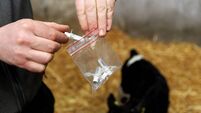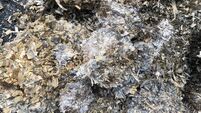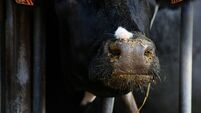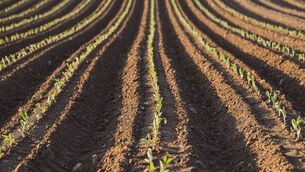Wealth hidden in the foliage
Even while there is over-production of many agricultural commodities, growers who have taken note of the bounty of nature around them are selling an estimated €1.5m worth of decorative branch cuttings from forest and wild foliage. And when you add their plantations of Eucalyptus, Pittosporum and many other ornamental plants, Irish growers are selling €3m per year of cut foliage for use in bouquets and other flower arrangements.
Farmers looking at their options in these changing times might well consider foliage cropping. Returns compare more than favourably to other farm enterprises, even dairying.
Worldwide demand for cut foliage in developed countries is increasing, and prospects for continuing export expansion of the Irish industry are very good, says Andy Whelton, the Teagasc expert in cut foliage, based in Killarney, Co Kerry.
About 70% of Irish production is exported to the UK and about 20% to Holland. The home market accounts for about 10% of sales, mostly to florists.
With greater demand for more ‘natural’ looking products, wild and forest species sales will increase in the future, predicts Andy Whelton. Wild species such as Rhododendron, Birch, Pine and Noble Fir are important.
There are significant increases in demand for cut foliage, year on year, the peak periods being Christmas, Valentines Day and Mothers Day. As a result, Ireland’s largest producer and processor, Forest Produce Ltd in Co Kerry, has scaled up its plantings in the last couple of years, adding more than 100 acres in Wexford, Waterford and Cork.
Plantations are also located in Co Kerry, and the overall area of crops for cut foliage now is around 350 acres.
Growers in the south of Ireland enjoy a climatic advantage over cut foliage producers in much of Northern Europe. In sheltered sites the south of Ireland’s relative freedom from frosts and cold winds allows a longer season for growing healthy, superior quality foliage. However, some species of in-demand foliage benefit from a period of ‘colder’ autumn and winter conditions.
Growers generally manage their own crops, and are paid by the cut stem. An initial outlay of about €4,200 per hectare (€1,700 per acre) is needed. Basic skills in crop husbandry are required, and technology is available for planting. There must also be a commitment to follow management plans and to co-operate with others in regard to production, harvesting and marketing.
The expected annual return, after the third year, should be €1,750 to €2,250 per ha (€700 to €900 per acre) for up to 12 years. The returns can be even greater if one decides to harvest and handle all their own material without involving the processing company. This, however, is not advisable, given the demands for orders, particularly at the peak times like Christmas and Valentines Day, and the necessity to maintain strict quality requirements. Harvesting is labour intensive, and is usually carried out by gangs of foreign nationals who are trained at the beginning of a season and move from site to site.
Experience suggests that a minimum size unit of 6 to 8 ha (15 to 20 acres) is necessary, and that there would need to be at least 40 ha (100 acres) established in any one area to justify the organisation involved from production right through to processing and dispatch to market.
Agriculture Minister Mary Coughlan recently gave the go-ahead for foliage to be planted on set-aside land, and is also allowing farmers to consolidate entitlements under the single farm payment, as is the situation with forestry.
Added Value: While foliage sales so far have consisted mainly of cut stems, returns could be greatly increased by the export of added value products such as finished artistic arrangements of centre pieces, table arrangements and posies. Product development is a significant element of the work of Forest Produce Ltd in Kerry. They work closely with plants specialist Jim Kelly, formerly of Teagasc, Kinsealy, and internationally renowned florist Richard Haslam, on utilising Irish foliages to develop new products.
Need for technical back-up and research and development
With the rapidly increasing demand for indoor decoration, prospects for Ireland’s cut foliage industry are good, but its potential depends on effective technical and research support. When ornamentals are mass planted, they become much more susceptible to pests and diseases.
This was evidenced a few years ago when psyllids, a greenfly-like insect, threatened the viability of eucalyptus plantations by making the foliage unsaleable.
With good research support, this problem was rapidly cleared up by the release of a tiny parasitic wasp from Australia, in a technique known as biological control. The success of this technique has meant the elimination of chemical pest control measures in this crop.
The development of ‘organic’ systems of weed control and the move away from reliance on chemicals is becoming an important aspect of the production of foliage crops. Given Ireland’s year round weed growth, the solution to this problem is unlikely to be achieved easily, but this work is ongoing.
COFORD Trials: Types of foliage go in and out of fashion, as buyers look for new colours, textures and scents. In the south of Ireland, Teagasc continues to evaluate a wide range of ornamental plants with potential for foliage, and several are now being scaled up in commercial plantings. These include some ‘hardier’ species such as Viburnum and Rosmarinus. The scope is enormous, as it includes not only attractive exotic species, but also native plants, including forest species like Larch and Hemlock, and moss and even rushes!
COFORD, the council for forest research and development in Ireland, are supporting two new projects — evaluating conifers and associated woodland species for foliage suitability, and an MSc programme where graduate Amy Costello is developing management protocols for forest species such as Hemlock, where a dual crop is taken of foliage and timber.
Andy Whelton of Teagasc says major challenges lie ahead, as we continue to develop the industry. Success will depend on a high level of market co-ordination and production based on committed, professional growers with solid research and technical backup, says the Teagasc expert.












